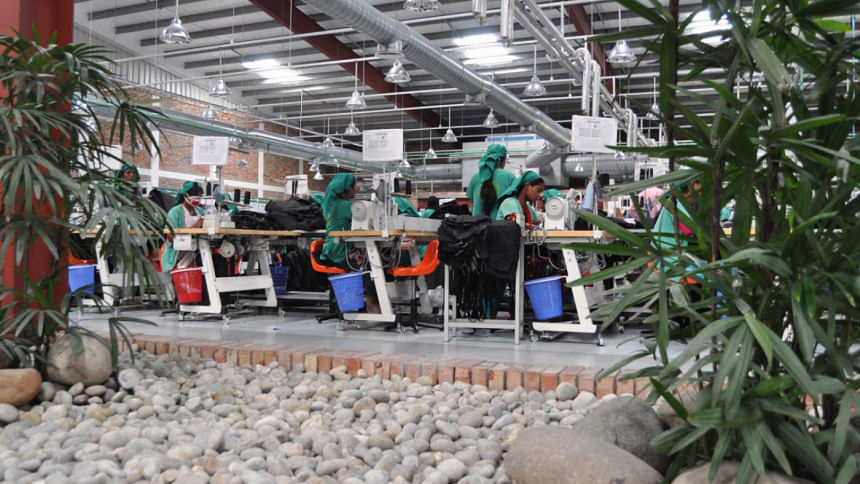Reducing the environmental impact of RMG industry

On April 22, people in countries across the world took part in a global day of political and civic action for World Earth Day, an annual event dedicated to environmental protection, first celebrated in 1970. While much of the news around World Earth Day had a Western bias, with a focus on demonstrations and marches in the likes of London, Paris and New York, this day of environmental awareness-raising activities is of huge relevance to countries such as Bangladesh. In fact, it is arguably of more relevance to Bangladesh, and other parts of Asia, than the rest of the world as environmental challenges and the impact of climate change are more pressing issues here.
With the messages of this day still fresh in our mind and as we brace for the aftereffects of cyclone Fani, which hit Bangladesh yesterday, perhaps it is an appropriate time to consider environmental and climate challenges for Bangladesh—particularly the interaction between industry and the environment—and also to consider why we all need to begin thinking much more carefully about how we use the earth's precious resources.
The first thing to note in this context is that Bangladesh, like many other Asian countries, is particularly vulnerable to climate change. Extreme weather events have already caused chaos in the country and led to shifts in migration and poverty patterns.
For instance, in 2017, 6.8 million people in north-western Bangladesh found their land and crops drowned under flood water. The totally submerged land constituted over 16,000 hectares, while another 560,000 hectares of crops were partially damaged. Meanwhile, in April the same year, floods damaged around 220,000 hectares of ready-to-be harvested crops, according to the UN Food and Agriculture Organization (FAO). Official estimates suggest that in 2017 alone, the floods severely affected the livelihoods of at least eight million people in Bangladesh.
There is a human cost and a business cost here—and clearly, the two are intertwined. For three years in a row, the World Economic Forum's Global Risk Report has identified climate change as the gravest threat for global business and industry. The report notes that "failure in climate change mitigation and adaptation—water crises—natural disasters" will impact business and industry worldwide.
Ready-made garment (RMG) production, which constitutes the largest industry in Bangladesh in terms of contribution to gross domestic product, is a resource-hungry and pollution-intensive sector. And it is an industry that will have to keep an increasingly close eye on its environmental impact moving forward.
It is well-known that washing, dyeing, and finishing of textiles require large amounts of clean freshwater, and can range from under 100 to more than 300 cubic metres per tonne of textiles, according to World Bank data. Assuming an annual textile production of five million tonnes, it is estimated that an average factory in Bangladesh consumes 300 litres of water per day. Replicate this water usage across the many thousands of RMG factories in Bangladesh, and the scale of water use becomes clear. Consider, also, that most of this water is sourced from groundwater wells.
The total water usage by the textile industry in Bangladesh is estimated to be 1,500 million cubic metres, which is principally made of groundwater. Around 70 percent of this water consumption is estimated to take place in wet processing of textiles, which involves the washing, dyeing, and finishing of textiles.
Though the growth of green garments in Bangladesh in recent times has been commendable—82 garment factories in the country have been LEED-certified by the United States Green Building Council (USGBC) and 320 more factories have registered for LEED certification, which is the highest in the world—the textile industry still faces the challenge of dealing with the problem of effluent discharge and the use of coagulants and chemicals for its treatment. This poses a huge problem for the industry, particularly for small- and medium-sized units which do not always have the cash to invest in the latest effluent treatment technology.
The government and the industry need to respond accordingly. On the one hand, they need to make water conservation a priority, and on the other, they need to ensure that the industry is treating and disposing of this water in the correct manner. These twin challenges will be critical for the RMG industry, and the environment, moving forward.
It is agreed within the industry that water conservation and rainwater harvesting can be better promoted across the industry, and many RMG operators are already going in this direction. They are investing in modern technology, which includes processing equipment that makes more efficient use of water and also better treatment technology, including high-tech wastewater treatment equipment. The industry is certainly going in the right direction, but more support is needed from the government and also the international buyers, which are heavily dependent on our industry.
It is also worth considering that saving water and other input resources actually makes economic sense in the long run. It is well-documented that simple changes to production techniques aimed at improving efficiencies can yield financial returns in the form of reduced water, electricity and chemical use. The return on these investments can be quick—often just one or two years.
Regardless, these are investments all businesses in our industry need to be addressing as a matter of urgency, for the sake of their long-term well-being, and for the sake of our country and the planet.
Mostafiz Uddin is the Managing Director of Denim Expert Limited. He is also the Founder and CEO of Bangladesh Denim Expo and Bangladesh Apparel Exchange (BAE). He can be reached at [email protected].

 For all latest news, follow The Daily Star's Google News channel.
For all latest news, follow The Daily Star's Google News channel. 








Comments